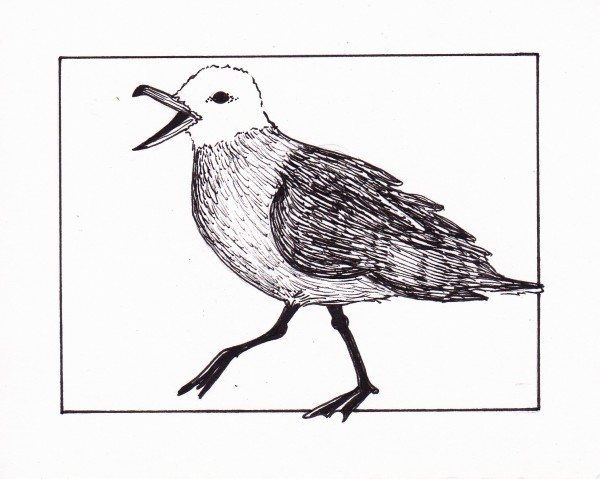Black Footed Beach Thief

With its red bill tipped in black and its black legs and webbed feet, the Heerman’s gull (Larus heermanni) is one of the most easily recognizable seagulls found in Laguna. Often seen on the beach congregating with other species of seagulls, the bird is considered a medium sized gull at approximately 20 inches in length and a wingspan of almost four feet. Before developing their adult plumage at around four years of age, juveniles are uniformly mottled brownish gray. Adults have a dove gray colored belly and their body and wings are a dark slate-gray. When in its breeding plumage, the head is white but when seen in Laguna, the head is most often in its mottled gray non-breeding plumage. They live to a maximum age of 24 years.
Feeding primarily on small pelagic fish like sardines and anchovies, Heermann’s gulls also eat marine invertebrates such as crustaceans and mollusks as well as herring eggs, lizards and insects. They are known to steal food from other seabirds, especially pelicans, and like other seagulls, are scavengers of edible debris and trash found along beaches, marshes, estuaries and lagoons. Like other mid-sized seagulls, the Heerman’s gull drinks both fresh water and salt water and excretes the excess salt from their nasal glands.

The range of the Heerman’s gull is exclusively along the coast of the Western-Pacific Ocean from its nesting grounds on islands in the Gulf of California to its most northern point in southern British Columbia. They are one of the few birds and the only seagull that exhibit reverse migration and instead of migrating north to breed and nest, they breed and nest in the south. Like most seagulls, Heermann’s gulls are monogamous and generally mate once a year. In fact, over 90% of the breeding pairs nest off Baja California on Isla Rasa and Little Cardinosa Island. Forming large, dense colonies, their nests are located in depressions on level ground that are lined with grass and feathers. Arriving to the breeding areas by March, they lay two to three eggs that are incubated by both parents until they hatch in about 30 days. Both parents feed the babies. In late May, they will migrate north, stopping along the coast before arriving at their non-breeding grounds on the Central to Northern California coast. They are occasionally found as far north as British Columbia where they will remain until late November.
The total population of Heerman’s gulls is thought to be stable and number over 500,000 birds but they are considered near threatened on conservation lists. Specific predators of the eggs and chicks of Heerman’s gulls include rodents, ravens, peregrine falcons and yellow-footed gulls. Though Isla Raza, where most of the birds breed, has been a designated wildlife sanctuary since the 1960s, it is a small area and therefore vulnerable to human disturbance from tourism, egg harvesting by fisherman, pollution and industrial activities. Natural environmental disturbances like El Niño and rising ocean levels due to climate change are also of concern. If you bring you bring food to the beach, keep it secured inside gull-proof containers. Gulls are very smart and have figured out how to open closed bags on the beach
Residents Mia Davidson and artist Jan Sattler are year round ocean swimmers. Laguna Beach is a state marine reserve and it is unlawful to take or disturb the habitat and its resources.




